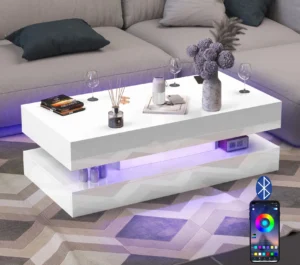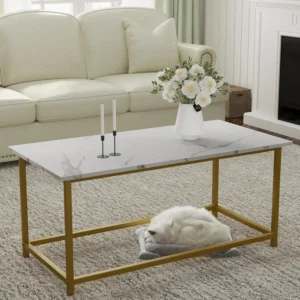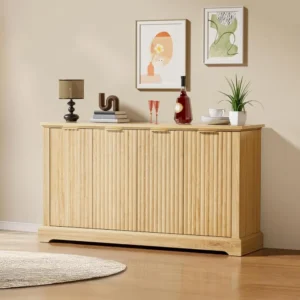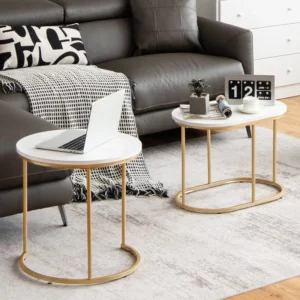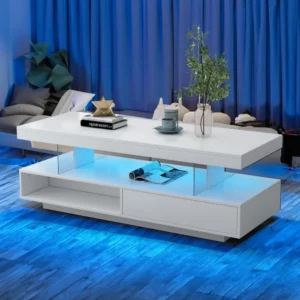Introduction: Mid-Century Tables as Timeless Design Centerpieces
Mid-century modern tables represent one of the most enduring furniture styles, characterized by their clean lines, organic forms, and seamless blend of function and beauty. These iconic pieces typically feature natural materials like walnut, teak, and oak, with minimalist designs that prioritize both form and function. The simplicity and elegance of these tables have made them increasingly popular in contemporary homes, despite their origins dating back to the post-war era.
The resurgence of mid-century modern furniture in today’s interior design landscape speaks to the timelessness of these pieces. Their ability to complement both traditional and contemporary settings makes them versatile additions to any home. When selecting a large mid-century coffee table, one of the most significant decisions homeowners face is choosing between rectangular and round shapes.
This choice extends beyond mere aesthetics – it impacts how you use your space, the dining experience you create, and how your furniture interacts with the room’s overall design. In the context of mid-century modern table design, a “large” table typically refers to rectangular tables exceeding 72 inches in length or round tables with diameters of 48 inches or more, both designed to accommodate six or more people comfortably.
Evaluating Your Space and Requirements Before Choosing
Before deciding between rectangular and round tables, you’ll need to carefully assess your space and requirements. Start by measuring your dining area, accounting not just for the table but also for comfortable movement around it. Generally, you should maintain at least 36 inches of clearance between your table edge and any walls, furniture, or other obstacles to allow for chair movement and easy passage.
Consider how your room’s geometry might influence your table choice:
* Square rooms often complement round tables
* Rectangular or long rooms typically work better with rectangular tables
* Open floor plans offer flexibility for either shape, depending on how you define the dining zone
When arranging a room with a large coffee table, think beyond the physical dimensions to consider how you typically use the space. Ask yourself:
* How many people regularly sit at your table?
* Do you frequently entertain larger groups?
* Will the table serve multiple purposes (dining, working, crafts, family activities)?
* Is space at a premium, requiring maximum efficiency?
The answers to these questions will guide your decision-making process, ensuring that whichever style you choose—rectangular or round—it will serve your needs effectively while honoring the authentic principles of mid-century design.
Large Rectangular Mid-Century Tables: Key Characteristics
Rectangular mid-century tables evolved significantly throughout the design movement, from the early experimental forms of the 1940s to the refined, production-friendly designs of the 1970s. These tables embody the mid-century ethos through their streamlined forms that emphasize horizontal planes and clean edges.
The distinctive elements of these tables include:
* Minimalist silhouettes with emphasis on long, uninterrupted surfaces
* Slim profiles that create a sense of visual lightness despite their size
* Tapered edges that reduce visual bulk and enhance the floating appearance
Traditional materials play a crucial role in the authenticity of rectangular mid-century coffee tables. Walnut remains the quintessential choice, prized for its rich grain and warm tones, while teak and rosewood offer alternatives with distinctive character. The beauty of these woods is often highlighted through oil finishes that enhance the natural grain rather than concealing it.
Leg configurations contribute significantly to the mid-century aesthetic, with options including:
* Tapered legs that angle outward slightly (splayed legs)
* Hairpin metal legs that provide structural support with minimal visual weight
* Straight, pencil-thin legs that emphasize vertical lines
What constitutes “large” in the realm of rectangular mid-century tables typically starts at 72 inches (183 cm) in length, with many extending to 84 or even 96 inches for more substantial dining spaces. These dimensions reflect the mid-century commitment to generous yet efficiently proportioned spaces for gathering.
The clean, horizontal lines of these best rectangular mid-century coffee tables perfectly complement the architectural principles of the era, creating harmony between furniture and space that remains relevant in contemporary design.
Advantages of Large Rectangular Mid-Century Tables
Exceptional Seating Capacity: Rectangular tables excel at accommodating larger groups, typically seating 6-10 people or more depending on length. Their linear arrangement provides clearly defined seating positions that maximize capacity while maintaining comfort.
Generous Surface Area: The expanded dimensions of rectangular tables offer substantial surface area for elaborate meal service, decorative centerpieces, and serving dishes. This makes them ideal for family-style dining where many dishes are shared.
Space Definition: In open-concept living spaces, rectangular tables create natural boundaries that help define the dining area as distinct from surrounding spaces. Their linear form establishes clear sight lines and traffic patterns.
Extension Mechanisms: Many mid-century rectangular tables feature ingenious extension systems—from hidden leaves to butterfly mechanisms—that allow them to transform from everyday dining tables to expansive surfaces for special occasions.
Formal Structure: The geometric precision of rectangular tables lends a sense of formality and order to dining spaces, creating a dedicated environment for meals and gatherings that feels purposeful and established.
Multi-Functional Utility: Beyond dining, these tables provide excellent surfaces for work projects, crafts, games, and other activities requiring extended flat surfaces. Their proportions make them adaptable to various uses throughout the day.
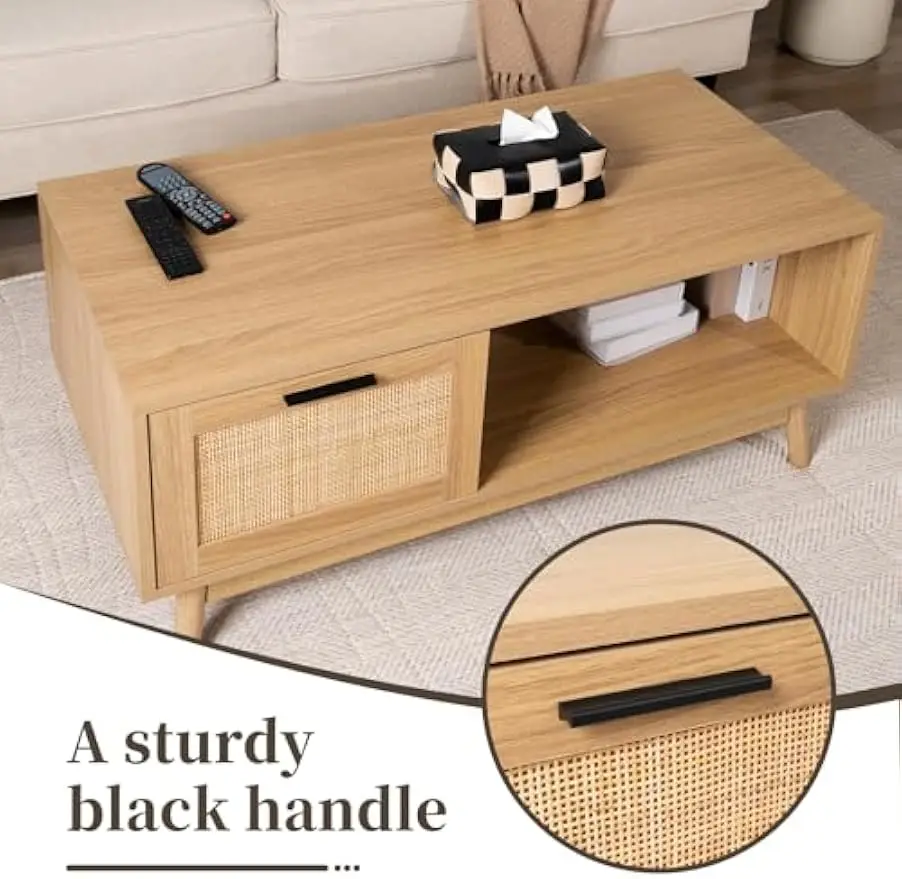
Limitations of Large Rectangular Mid-Century Tables
While rectangular tables offer numerous advantages, they also come with certain limitations worth considering before making your selection:
Substantial Space Requirements: Large rectangular tables demand significant floor space, not just for the table itself but also for proper clearance. In smaller rooms, they can feel overwhelming and restrict movement.
Conversation Challenges: Very long tables can create distance between diners seated at opposite ends, sometimes making conversation difficult across the entire table. This can affect the intimacy of gatherings.
Traffic Flow Concerns: The corners of rectangular tables can create pinch points in traffic patterns, especially in tighter spaces. This sometimes requires careful chair arrangement to prevent blockages.
Visual Weight: Despite the lightness of mid-century design, large rectangular tables can appear visually heavy in certain spaces, dominating the room’s aesthetic rather than complementing it.
Corner Seating Issues: The corners of rectangular tables can create awkward seating positions, particularly when trying to maximize capacity. These spots often provide less comfortable access to the table surface.
When comparing rectangular vs. square coffee tables, the rectangular option typically offers more flexibility but requires more thoughtful placement within the room to avoid these potential drawbacks.
Large Round Mid-Century Tables: Distinctive Features
Round tables represent some of the most iconic forms in mid-century furniture design, with their organic shapes perfectly embodying the era’s embrace of natural, flowing lines. These tables evolved as designers explored the possibilities of new manufacturing techniques and materials.
The most distinctive feature of round mid-century tables is often their base design. Pedestal bases gained tremendous popularity during this period, with the tulip-style base becoming particularly emblematic of mid-century innovation. These central supports eliminate the need for corner legs, creating clean visual lines and maximizing leg room.
Material choices for round mid-century coffee tables typically include:
* Solid hardwoods like walnut and oak for the table surface
* Plywood with wood veneer for gently curved forms
* Metal components (often aluminum or steel) for pedestal bases
* Occasionally glass for more dramatic, space-age designs
Edge treatments on round tables showcase the mid-century attention to detail, with options ranging from beveled edges to gentle lip details that prevent items from sliding off. These subtle touches enhance both the visual appeal and functionality of the pieces.
In mid-century design, “large” round tables typically start at 48 inches (122 cm) in diameter, with truly substantial pieces reaching 60 inches (152 cm) or more. These dimensions allow comfortable seating for 6-8 people while maintaining the intimate feel that makes round tables special.
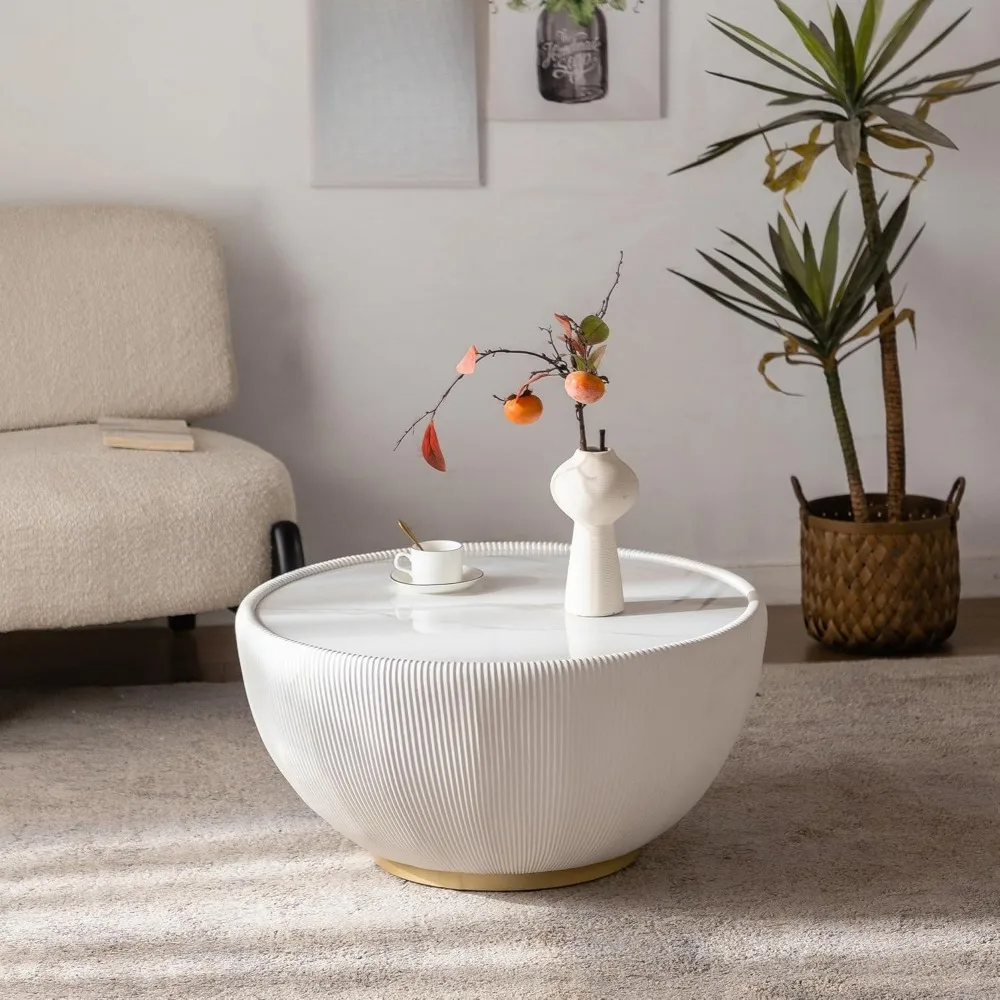
Benefits of Large Round Mid-Century Tables
Enhanced Social Interaction: The circular form creates an inherently social dining arrangement where everyone can see and engage with each other easily. This face-to-face positioning promotes more inclusive conversations compared to rectangular alternatives.
Intimate Atmosphere: Even at larger sizes, round tables foster a sense of togetherness and intimacy. The absence of corners means no one feels “left out” of the gathering, creating a more egalitarian dining experience.
Improved Traffic Flow: The absence of sharp corners makes round tables easier to navigate around, especially in tighter spaces. This smooth perimeter allows for more fluid movement throughout the room.
Space-Efficient Pedestal Bases: Many round mid-century tables feature central pedestal bases that maximize leg room and chair placement flexibility. This design eliminates the awkward “corner leg” problem of rectangular tables.
Visual Statement: Round tables create a dramatic focal point in dining spaces, their organic shape providing visual interest and softness amid the typically angular elements of room architecture.
Design Harmony: The circular form beautifully complements other curved elements found in mid-century design, creating cohesion with defining aesthetic features of round mid-century tables like shell chairs, curved sofas, and arc lamps.
Softening Effect: In rooms with many hard angles and straight lines, round tables introduce a welcome organic element that softens the overall aesthetic and creates visual balance.
Drawbacks of Large Round Mid-Century Tables
Despite their many advantages, large round tables present certain challenges worth considering:
Reach Limitations: As diameter increases beyond 60 inches (152 cm), reaching across to serve or access items at the center becomes increasingly difficult. This can affect the practicality of very large round tables.
Surface Area Efficiency: Compared to rectangular tables of similar floor space, round tables provide somewhat less usable surface area due to their geometry. This reduction might impact serving capacity for larger gatherings.
Seating Capacity Ceiling: Round tables have practical limits to how many people they can comfortably accommodate. Beyond 8 people, most round tables become unwieldy in terms of both diameter and conversation distance.
Room Shape Compatibility: In long, narrow rooms, round tables can leave awkward unused spaces at corners, making them less efficient for certain room configurations.
Storage Challenges: Large round tabletops are more difficult to store when not in use compared to rectangular options, particularly for extension leaves that cannot be folded.
For those seeking versatility, large mid-century coffee tables in various shapes allow for exploration of different design approaches to address these potential limitations.
Direct Comparison: Space Efficiency and Room Compatibility
When evaluating space efficiency, the room’s existing geometry plays a decisive role in determining the most appropriate table shape:
Rectangular Tables:
* Excel in narrow or rectangular rooms by efficiently using the available space
* Create clear walkways along their long sides
* Allow placement against walls when not in use to free up floor space
* Provide maximum seating capacity for the floor space they occupy
* Work particularly well in open-plan settings to define dining zones
Round Tables:
* Shine in square rooms where corners might otherwise go unused
* Create more flexible traffic patterns with their continuous perimeter
* Reduce the visual mass in smaller spaces due to absence of corners
* Often appear to occupy less space than they actually do
* Function well as central elements in multi-purpose rooms
The minimum room dimensions needed vary by table size, but generally:
* A rectangular table needs at least 3 feet (91 cm) of clearance on all sides
* Round tables require similar clearance, but their shape eliminates corner concerns
When mastering space planning for oversized mid-century coffee tables, consider how each shape interacts with other furniture elements. Rectangular tables tend to establish formal alignments with other pieces, while round tables create more fluid relationships between furniture groupings.
Seating Capacity and Social Dynamics Compared
The table shape significantly influences both how many people can be seated and the quality of their interactions:
| Table Type | Size | Comfortable Seating | Maximum Seating |
|---|---|---|---|
| Rectangular | 72” (183 cm) | 6 | 8 |
| Rectangular | 84” (213 cm) | 8 | 10 |
| Rectangular | 96” (244 cm) | 10 | 12 |
| Round | 48” (122 cm) | 4 | 6 |
| Round | 54” (137 cm) | 6 | 8 |
| Round | 60” (152 cm) | 8 | 10 |
Beyond simple numbers, the social experience differs markedly between shapes:
Rectangular Tables:
* Create a clear hierarchy with distinct “head” positions
* Support formal dining protocols and traditional service styles
* Allow for targeted conversations between neighbors
* Provide structure for formal place settings and serving arrangements
* Enable hosts to strategically plan seating arrangements
Round Tables:
* Foster democratic, all-inclusive conversations
* Create a shared, communal dining experience
* Eliminate hierarchy in seating positions
* Allow easier passing of dishes among all diners
* Promote a more casual, relaxed atmosphere
Leg room considerations also vary, with pedestal-based round tables generally offering the most flexible leg positioning, while rectangular tables with four corners may create more constrained positions at the corners.
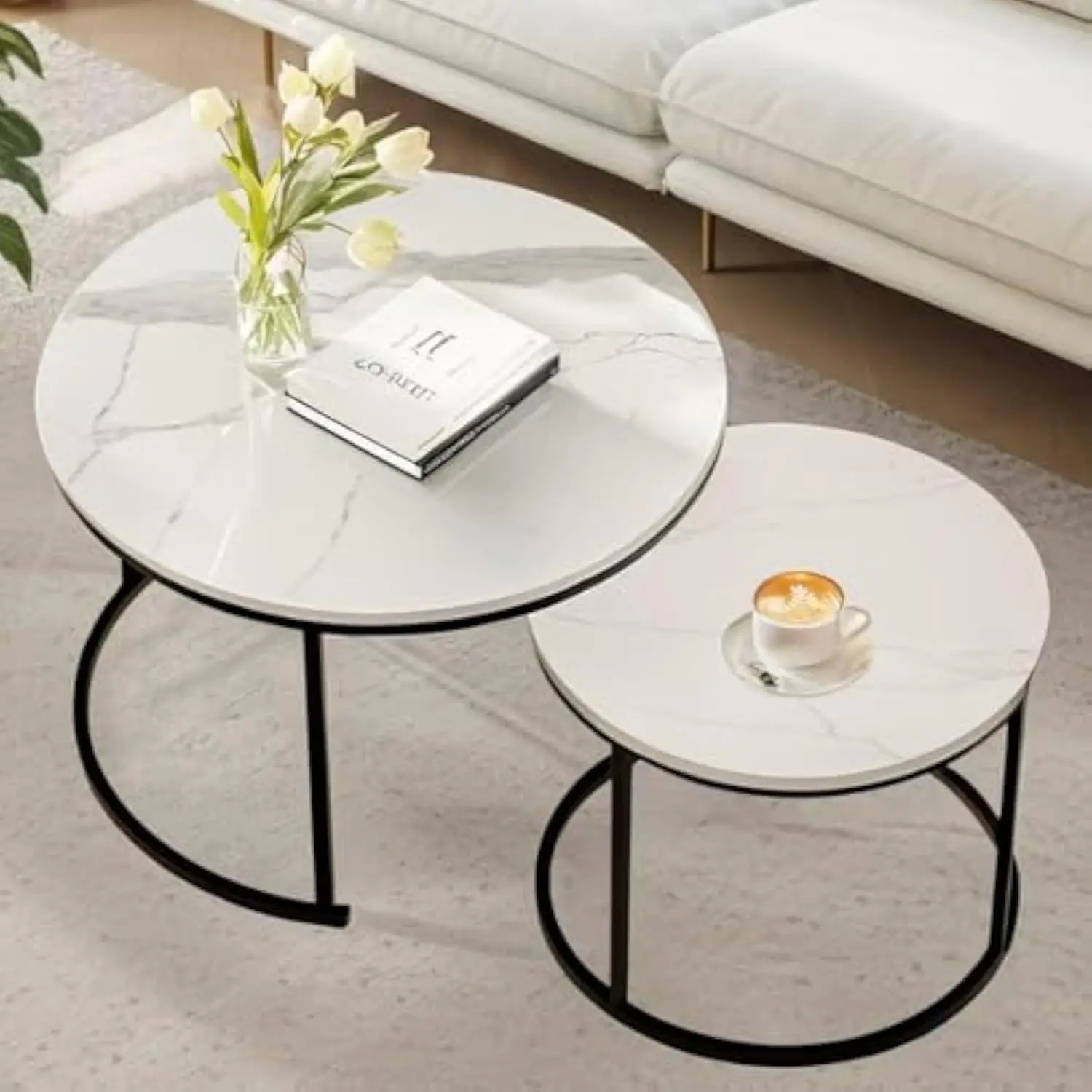
Design Harmony: Integrating Large Tables in Mid-Century Spaces
Each table shape contributes differently to the overall aesthetic harmony of mid-century interiors:
Rectangular Tables:
* Reinforce the linear geometry often found in mid-century architecture
* Create strong horizontal planes that echo architectural elements
* Establish a structured presence that anchors the dining area
* Provide clean lines that complement the rectilinear forms of many mid-century pieces
* Support the mid-century principle of functional minimalism
Round Tables:
* Introduce organic counterpoints to the straight lines of mid-century spaces
* Create dynamic visual interest through curved forms
* Soften rooms with too many angular elements
* Make bold statements with dramatic pedestal bases
* Embody the mid-century fascination with organic, biomorphic shapes
When considering material and finish selections, both table shapes benefit from authentic mid-century approaches: natural wood tones, honest material expression, and visible craftsmanship. The scale relationship between table and room is crucial—mid-century design principles favor proportional balance rather than overwhelming dominance.
The design advantages of large mid-century coffee tables extend beyond mere functionality to influence the entire atmosphere of a space, whether through the structured elegance of rectangles or the fluid sociability of rounds.
Practical Considerations: Function Beyond Form
While aesthetics are vital in mid-century design, these tables were created first and foremost as functional objects for daily use:
Serving and Surface Considerations:
* Rectangular tables provide more centralized surface area for elaborate spreads
* Round tables offer easier passing of dishes but less total surface area
* Centerpiece and décor options differ—linear arrangements for rectangular tables versus centered focal points for round tables
Multi-purpose Functionality:
* Rectangular tables better accommodate activities requiring defined workspace (crafts, paperwork)
* Round tables facilitate face-to-face activities like board games and conversations
* Both can serve as temporary workspaces, but with different organizational patterns
Stability and Construction:
* Large round tables with pedestal bases require careful engineering to prevent wobbling
* Rectangular tables with four legs offer inherent stability but may have leg interference
* Extension mechanisms vary in complexity and ease of operation between shapes
The functional uses of large mid-century coffee tables extend well beyond dining, and your choice should reflect your household’s unique patterns of use. Consider not just how you entertain, but how the table serves your daily needs when not hosting guests.
Finding Your Perfect Match: Decision-Making Framework
To determine which table shape best suits your needs, consider these key questions:
Space Assessment:
* What are the exact dimensions of your dining area?
* How does traffic flow through the space?
* What other furniture must coexist with the table?
* Is your room shape predominantly square, rectangular, or open-plan?
Usage Patterns:
* How many people regularly dine at your table?
* How often do you entertain larger groups?
* What non-dining activities regularly occur at your table?
* Do you need extension options for occasional use?
Aesthetic Priorities:
* Is your existing décor predominantly angular or curved?
* Do you prefer formal or casual dining atmospheres?
* How important is authentic mid-century design to your overall scheme?
* What other statement pieces will share the space?
For frequent entertainers with dedicated dining rooms, rectangular tables offer maximum capacity and formal presence. Families seeking multi-functional spaces might prefer the versatility and safety (no sharp corners) of round tables. Collectors focused on design authenticity should consider which iconic mid-century forms most resonate with their personal aesthetic.
Mid-Century Modern Coffee & End Table Sets, Mid-Century Modern Coffee Table Sets, Mid-Century Modern Oval Coffee Tables
Price range: $257.48 through $331.04 Select options This product has multiple variants. The options may be chosen on the product pageMid-Century Modern Large Coffee Tables, Mid-Century Modern Rectangular Coffee Tables
$603.26 Select options This product has multiple variants. The options may be chosen on the product pageMid-Century Modern Marble Top Coffee Tables, Mid-Century Modern Rectangular Coffee Tables, Mid-Century Modern White Coffee Tables
Price range: $163.28 through $189.22 Select options This product has multiple variants. The options may be chosen on the product pageMid-Century Modern Coffee Table Sets
$443.74 Select options This product has multiple variants. The options may be chosen on the product pageMid-Century Modern Nesting Coffee Tables, Mid-Century Modern Nesting Table Sets
$361.45 Select options This product has multiple variants. The options may be chosen on the product pageMid-Century Modern Rectangular Coffee Tables, Mid-Century Modern White Coffee Tables
$605.68 Select options This product has multiple variants. The options may be chosen on the product page
Those with space constraints might explore mid-century modern nesting coffee tables as versatile alternatives that provide flexibility while maintaining authentic design elements.
Beyond the Table: Completing Your Mid-Century Dining Setting
The table is just one element in creating a cohesive mid-century dining environment:
Chair Selection: Choose chairs that complement your table’s form—organic, sculptural chairs pair beautifully with round tables, while more geometric forms often harmonize with rectangular tables.
Lighting Placement: For rectangular tables, consider linear lighting elements that parallel the table’s form. Round tables benefit from centered pendant fixtures that echo their shape.
Rug Dimensions: Rugs should extend at least 24 inches (61 cm) beyond the table edge on all sides. For rectangular tables, this means a rectangular rug; for round tables, either round or rectangular rugs work depending on the room.
Appropriate Accessories: Mid-century design favors purposeful simplicity—choose a few quality accessories rather than cluttering the table with too many objects.
Creating a complete mid-century dining environment means understanding the relationship between all elements. The mid-century modern coffee table sets available through Hearth Forms demonstrate how these pieces can work together to create a unified design statement.
Making Your Final Decision: Practical Next Steps
As you move toward a final decision between rectangular and round tables, consider these practical steps:
Create Physical Templates: Use cardboard or paper to create full-size outlines of prospective tables in your space. This allows you to visualize traffic flow and spatial relationships before purchasing.
Assess Material Quality: Whether vintage or contemporary, look for solid construction, quality joinery, and authentic materials that align with mid-century principles.
Consider Authenticity Factors: For vintage pieces, research signature details of different designers and manufacturers. For contemporary pieces, look for faithful adherence to original design principles rather than superficial styling.
Evaluate Construction Details: Check for quality hallmarks like dovetail joints, solid wood construction (or appropriate use of veneers), and durable finishes that will withstand daily use.
Understanding the features of large mid-century modern tables will help you identify quality pieces whether you choose rectangular or round. Remember that the best choice balances your practical needs with your aesthetic preferences while honoring the design principles that make mid-century furniture enduringly appealing.
Both rectangular and round mid-century tables offer distinctive benefits. The perfect choice depends on your specific space, needs, and design vision—with either option providing a timeless centerpiece for your home.



